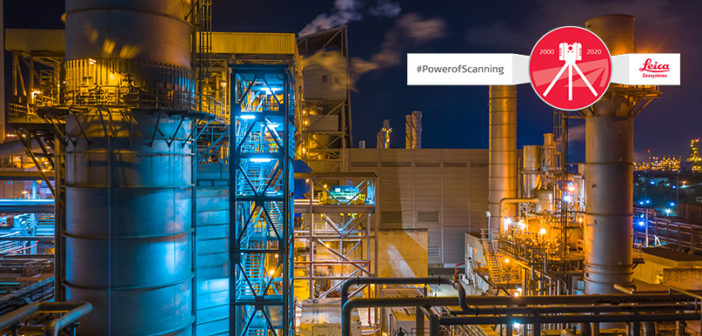Creating an ‘as-built’ representation of a large industrial site is a complex task. It requires capturing intricate details on a vast scale, as quickly and accurately as possible, and all without closing the site or causing disruption. What’s more, on many sites, whole areas are restricted or unsafe to enter, making the job trickier still.
So it’s clear surveyors carrying out this work need a tool that’s up to the task. Here are five reasons why you should use a 3D terrestrial laser scanner, such as the Leica ScanStation P30, P40 or P50, when documenting existing industrial structures.
 1. Capture the entire site in high detail, all from a safe vantage point
1. Capture the entire site in high detail, all from a safe vantage point
First, a 3D terrestrial laser scanner allows you to maintain a safe distance at all times. As we briefly mentioned, by their nature many industrial sites contain areas that are either restricted or unsafe for a surveyor to get too close — think of an area with live electricity or the reactor of a nuclear power plant for example.
Equipment like the ScanStation P50 survey-grade laser scanner allows you to capture structures in high detail from up to 1 kilometre away. So there’s no need to approach dangerous areas or sacrifice accuracy to stay safe. With the right equipment, it’s possible to do both.
 2. Find equipment failures or malfunctions before they cause issues
2. Find equipment failures or malfunctions before they cause issues
It’s often overlooked as a benefit of using them, but 3D laser scanners can even help you keep ahead of which equipment needs replacing or updating. The models produced by 3D laser scanners capture all the architectural, structural and mechanical systems at a site, to a millimetre of detail.
These models are so comprehensive that they’ll pick up, and bring to light, things that might not be obvious to the naked eye. So you’ll know about that overhead conveyor or jig welder that’s in danger of breaking down, long before it actually does — saving you money and lost production days.
 3. Document everything first time without having to return to the site
3. Document everything first time without having to return to the site
The 3D data captured with laser scanners, such as the ScanStation P-Series range, is so thorough that almost every detail is recorded. So much so that the chances of any omissions from the data are minimal. This means there’s rarely any need to revisit the site to capture missed measurements.
The best laser scanners will work alongside a 3D point cloud post-processing office software suite. Tools such as JetStream Viewer allow surveyors to revisit the site virtually as often as they like. These virtual visits are so realistic that the need to revisit the site is eliminated. JetStream Viewer supports virtual walk throughs, presentations and even virtual retrofit and equipment replacement projects thanks to its support for industry-standard models alongside point clouds. In most cases, it’s even possible for surveyors to work on sites they’ve never actually visited thanks to the level of detail and intuitive navigation of the viewer.
 4. Rapid measurement
4. Rapid measurement
Perhaps the simplest benefit of 3D terrestrial laser scanners is speed. The ScanStation P-Series have a scan rate of up to one million points per second, meaning even the largest structures can be captured in just a few minutes.
Rapid capture is vital for time-sensitive projects or those that require minimal disruption to site facilities, allowing surveyors to get in, capture everything they need and get out quickly. What’s more, high measurement speeds greatly reduce the hours surveyors spend on-site doing the ‘capture’ element of their role. This means more time can be spent doing ‘high value’ tasks such as the final registration, modelling and analysis of the data.
 5. Develop plans for more efficient uses of space and equipment installation with complete data on the layout of the complex
5. Develop plans for more efficient uses of space and equipment installation with complete data on the layout of the complex
Finally, 3D terrestrial laser scanners can help businesses better use the space at their disposal. The 3D models produced with the data from a laser scanner are so detailed that they can be used to perform virtual deployments of equipment, machinery and even vehicles.
For businesses, this means the power to move equipment around a plant, assess different layouts, plan vehicle routes to avoid collisions and find the most cost-effective and efficient use of space. Yet, not a single piece of machinery or equipment needs to be moved until the optimum layout has been found.
Fast, efficient and with a host of benefits that often get overlooked, 3D terrestrial laser scanners are the ideal tool for capturing large industrial complexes. Options such as the ScanStation P-Series range can help your surveyors do more, in less time and deliver added value through services like advising on the best deployment of equipment.
Contact us to learn more about the Leica ScanStation P-Series
Read the previous Leica ScanStation Blog – 6 key questions to ask when choosing a long-range laser scanner














